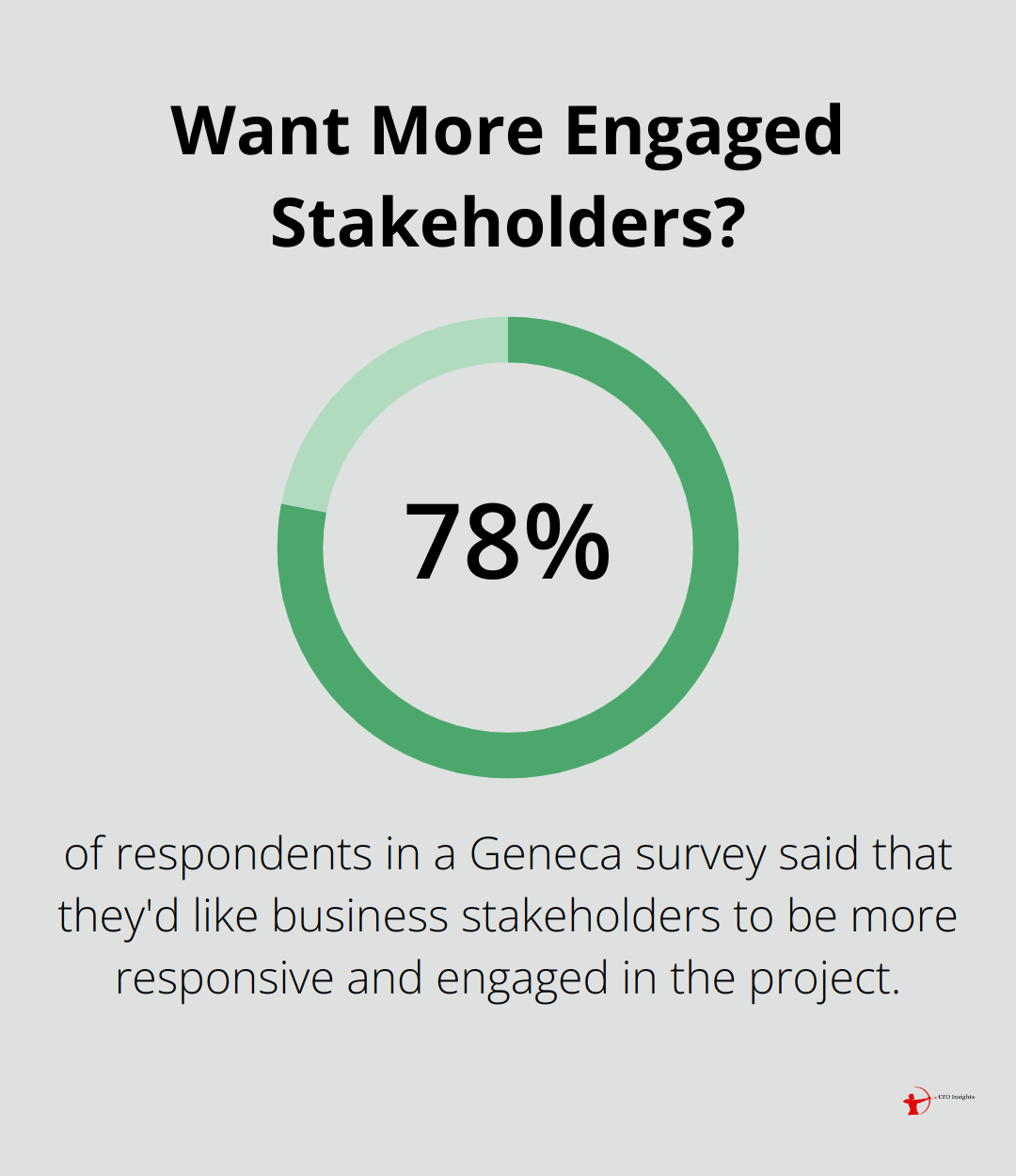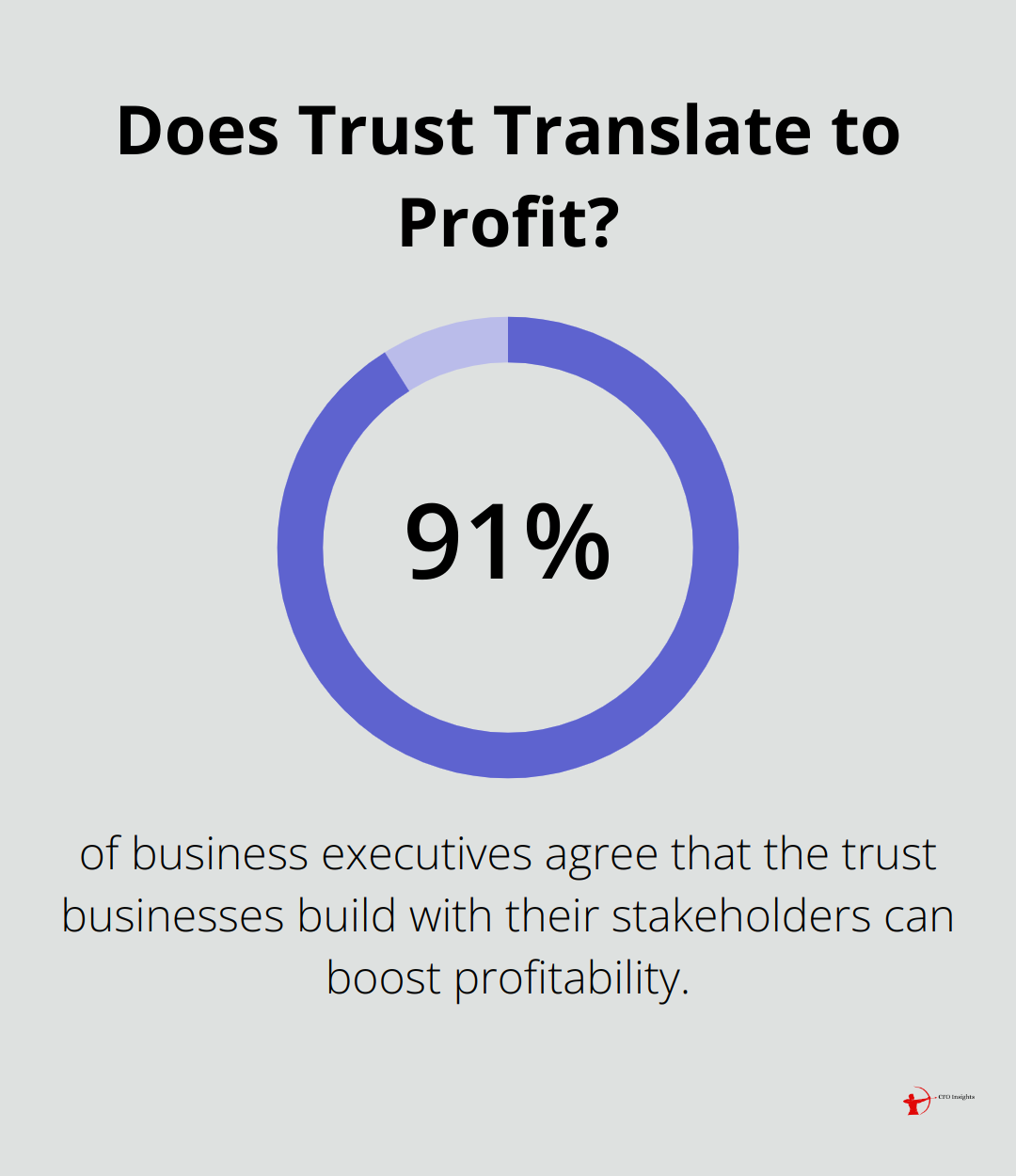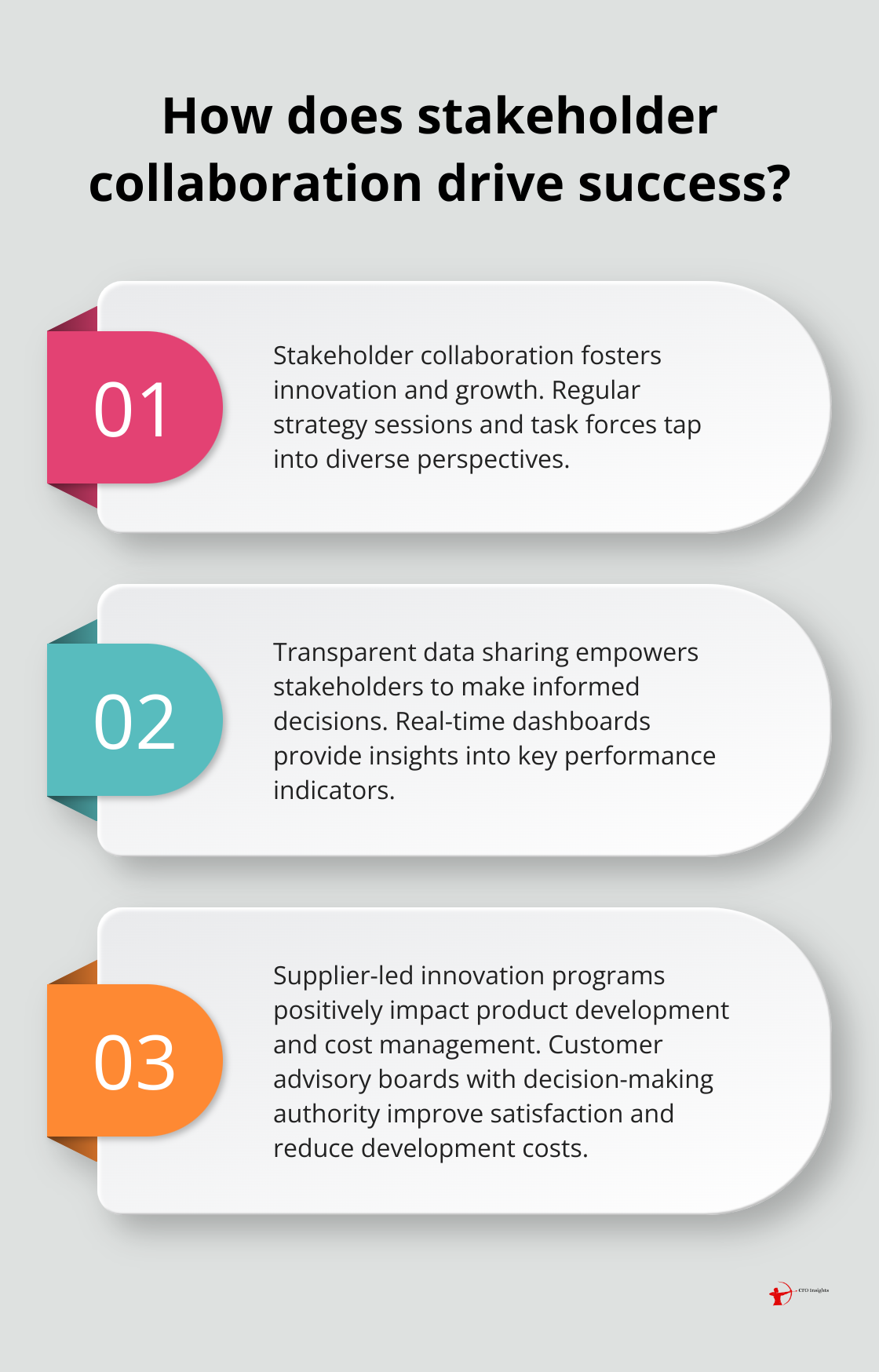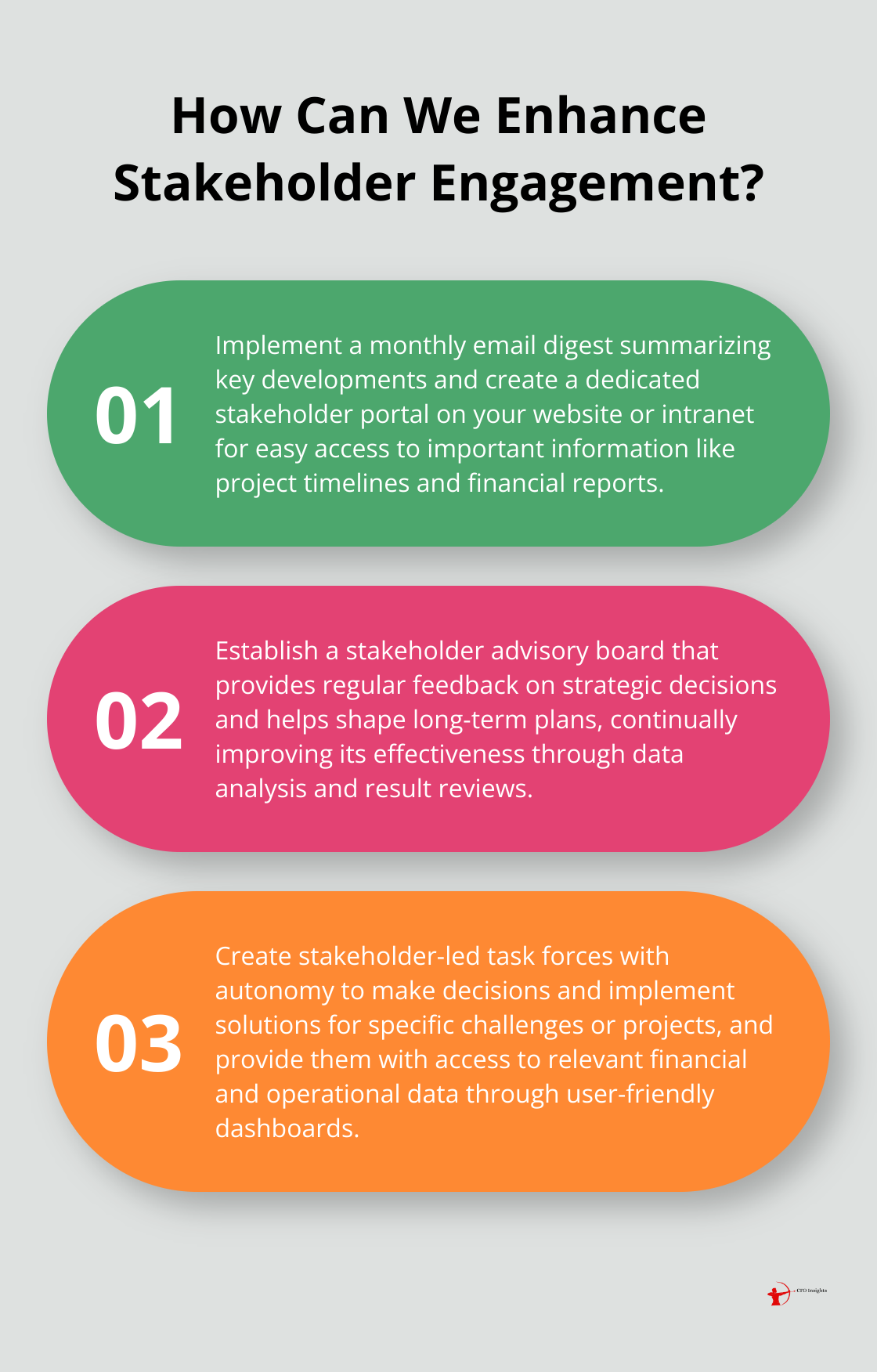At CFO Insights, we understand the importance of effective stakeholder engagement. The Stakeholder Engagement Pyramid is a powerful framework that can transform your approach to managing relationships with key players in your organization.
This blog post will guide you through each level of the pyramid, from basic information sharing to full collaboration and empowerment. We’ll also provide practical tips for developing a comprehensive stakeholder engagement strategy plan that can drive your business forward.
How to Lay the Foundation with Stakeholder Information
The Power of Informed Stakeholders
The base of the Stakeholder Engagement Pyramid consists of informing stakeholders. This foundational level sets the stage for all future engagement and builds trust and transparency.

Informing stakeholders means providing clear, accurate, and timely information about your organization’s activities, decisions, and plans. This proactive approach prevents misunderstandings and creates a solid foundation for future collaboration.
A study reveals that 78% of respondents in a Geneca survey said that they’d like business stakeholders to be more responsive and engaged in the project. This statistic underscores the importance of keeping stakeholders well-informed from the start.
Transparency: The Key to Trust
Transparent communication fosters an environment of openness and honesty. When stakeholders receive the full picture, they trust your organization more and support its initiatives.
The 2021 Edelman Trust Barometer reveals an epidemic of misinformation and widespread mistrust of societal institutions and leaders around the world. This highlights the need for proactive and transparent communication.
Effective Information Dissemination Strategies
To ensure your stakeholders stay well-informed, try implementing these practical methods:
- Regular Updates: Schedule consistent briefings or newsletters to keep stakeholders in the loop (e.g., a monthly email digest summarizing key developments).
- Dedicated Portals: Create a stakeholder-specific section on your website or intranet where important information is easily accessible (project timelines, financial reports, policy updates).
- Interactive Webinars: Host online sessions where stakeholders receive information directly from key personnel and ask questions in real-time.
- Data Visualization: Use infographics, charts, and dashboards to present complex information in an easily digestible format.
- Tailored Communication Channels: Different stakeholders may prefer different communication methods (email, face-to-face meetings, video calls). Tailor your approach accordingly.
The Impact of Effective Information Sharing
Effective information dissemination transforms stakeholder relationships. These strategies don’t just share information; they lay the groundwork for more advanced levels of engagement.
The goal at this level is to create a well-informed stakeholder base. This foundation will support your efforts as you move up the Stakeholder Engagement Pyramid towards more collaborative and empowering relationships.
As we progress to the next level of the Stakeholder Engagement Pyramid, we’ll explore how to move beyond simple information sharing to actively seeking input and involving stakeholders in decision-making processes.
How to Actively Engage Stakeholders
The Power of Stakeholder Input
Active stakeholder engagement transforms passive information recipients into key participants in your organization’s journey. PwC research found 91% of business executives agree that the trust businesses build with their stakeholders can boost profitability. This statistic highlights the value of stakeholder perspectives in driving innovation and growth.
Consultation vs. Involvement: Understanding the Difference
While both consultation and involvement aim to engage stakeholders, they differ in depth and impact. Consultation typically seeks opinions on predetermined options or decisions. Involvement brings stakeholders into the decision-making process itself.

For example:
- Consultation: Surveying stakeholders about preferences for a new product feature.
- Involvement: Including stakeholders in the product development team from the outset.
Techniques for Meaningful Stakeholder Participation
To truly engage your stakeholders, consider these practical techniques:
- Stakeholder Advisory Boards: Create a formal structure for ongoing stakeholder input. These boards provide regular feedback on strategic decisions and help shape long-term plans. Organizations should continually improve the effectiveness of their own advisory board by adopting a framework through analyzing data and reviewing results.
- Co-creation Workshops: Host collaborative sessions where stakeholders work alongside your team to develop solutions or strategies. This approach works particularly well for complex problems that benefit from diverse perspectives.
- Digital Engagement Platforms: Use technology to facilitate ongoing dialogue. Stakeholder management software can help teams compare features, pros, cons, and pricing to find the best solution for their needs.
- Scenario Planning Sessions: Include stakeholders in exploring potential future scenarios for your organization. This provides valuable insights and helps stakeholders feel more invested in your long-term success.
- Stakeholder Panels: Assemble diverse groups of stakeholders to provide input on specific projects or initiatives. This proves particularly useful when dealing with contentious issues or when seeking to balance competing interests.
The key to successful stakeholder engagement at this level lies in creating meaningful opportunities for input and demonstrating how that input influences your decision-making processes. This approach builds stronger relationships with your stakeholders and sets the stage for even deeper collaboration.
As we move forward, we’ll explore the pinnacle of stakeholder engagement: true collaboration and empowerment. This next level takes stakeholder relationships to new heights, fostering partnerships that drive innovation and create shared value.
How to Maximize Stakeholder Collaboration
Create a Culture of Collaboration
Organizations must create an environment where stakeholders feel valued and heard to foster genuine collaboration. This starts with open communication channels and a willingness to share decision-making power.

To avoid collaboration pitfalls, organizations should implement regular stakeholder strategy sessions. These meetings bring key stakeholders together to discuss long-term goals, potential challenges, and innovative solutions. Involving stakeholders in strategic planning taps into diverse perspectives and creates a sense of shared ownership.
Empower Stakeholders for Success
Empowerment extends beyond collaboration. It involves providing stakeholders with the tools, information, and authority to make meaningful contributions.
One effective strategy is to establish stakeholder-led task forces. These groups take on specific challenges or projects, with the autonomy to make decisions and implement solutions. This approach not only leverages stakeholder expertise but also builds trust and commitment.
Another powerful empowerment tool is transparent data sharing. Providing stakeholders with access to relevant financial and operational data enables them to make informed decisions and contribute more effectively. User-friendly dashboards that offer real-time insights into key performance indicators (KPIs) can be particularly useful in this regard.
Learn from Real-World Success Stories
The power of stakeholder empowerment is evident in numerous success stories across industries. For example, a mid-sized manufacturing company implemented a supplier-led innovation program. By empowering their suppliers to propose and develop new product ideas, they saw positive impacts on product development, cost management, and innovation.
In another case, a tech startup created a customer advisory board with decision-making authority on product features. This led to a significant improvement in customer satisfaction and a reduction in development costs as resources focused on features that truly mattered to users.
Implement Collaborative Tools and Techniques
To facilitate effective collaboration, organizations should leverage various tools and techniques:
- Digital collaboration platforms (e.g., project management software, shared document repositories)
- Regular feedback mechanisms (surveys, focus groups, one-on-one meetings)
- Cross-functional teams that include stakeholder representatives
- Collaborative problem-solving workshops
- Stakeholder-led innovation challenges
These examples demonstrate that when organizations move beyond traditional stakeholder management to true collaboration and empowerment, the results can be transformative. An environment of trust, shared responsibility, and mutual benefit unlocks new levels of innovation and growth.
To maximize success, it’s crucial to understand that team empowerment is a key component of effective stakeholder engagement. By utilizing practical tips and frameworks like the Stakeholder Engagement Pyramid, organizations can achieve more successful outcomes in their collaborative efforts.
Final Thoughts
The Stakeholder Engagement Pyramid transforms stakeholder relationships from passive to active partnerships. Organizations must map current relationships, set clear goals, and invest in appropriate tools to implement a comprehensive stakeholder engagement strategy plan. A culture of openness and transparency encourages feedback and demonstrates the impact of stakeholder input on decision-making.

We at CFO Insights recognize the importance of effective stakeholder engagement in financial management and organizational success. Our fractional CFO services can help develop and implement robust engagement strategies aligned with financial goals. Regular assessment and refinement of these strategies ensure their effectiveness for different stakeholder groups.
The Stakeholder Engagement Pyramid principles can turn stakeholder relationships into powerful drivers of organizational success. This journey presents challenges, but increased trust, improved decision-making, and enhanced innovation make the effort worthwhile. Organizations that embrace these principles position themselves for sustainable growth in today’s interconnected business landscape.
One thought on “Understanding the Stakeholder Engagement Pyramid”
Leave a Reply
You must be logged in to post a comment.





[…] and future prospects. One related article that may offer guidance on stakeholder engagement is Understanding the Stakeholder Engagement Pyramid. This article could help in formulating questions that address the concerns and interests of […]